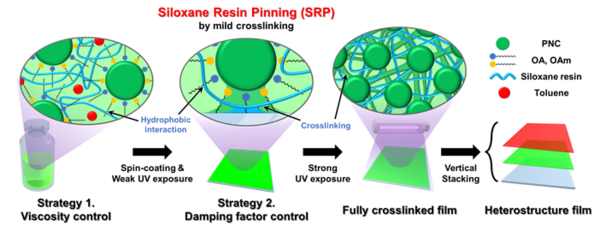Anticipated applications in next-generation high-resolution, long-lifetime microdisplays

On August 18, a joint research team led by Professor Kim Young-hoon(Department of Energy Engineering), Professor Kim Do-hwan(Department of Chemical Engineering), Professor Jung Yei-hwan(School of Electronic Engineering) at Hanyang University, and Professor Bae Byeong-soo(Department of Materials Science and Engineering, KAIST), announced that they have developed a 'perovskite nanocomposite color conversion layer pattern' that maintains stable photoluminescence quantum yield(PLQY) for extended time periods even underwater.
Metal halide perovskite nanocrystal (PNC) light emitters are attracting great attention as next-generation display color conversion materials because they are cheaper and offer higher color purity compared to conventional organic and inorganic light emitting materials. However, conventional materials have limitations such as poor stability and photoresist due to their ionic nature, and damage to the crystal structure during patterning processes such as etching.
To address these issues, the 토토사이트 가입거절 team synthesized a photo-crosslinkable nanocomposite by blending perovskite nanocrystals with siloxane resin, and used rheologically-controlled photolithography to create patterns tens of micrometers in size. As a result, high PLQY was maintained for over four months underwater. The team also successfully implemented multipatterning of green and red-emitting nanocomposites to achieve white light conversion on a blue backlight.

In this process, the siloxane resin played a dual role as it enabled photolithography without damaging the perovskite. Additionally, by optimizing the nanocomposite viscosity through solvent addition and separating the process into weak and strong photo-crosslinking stages, pattern uniformity was improved. Notably, the 토토사이트 가입거절 observed that small amounts of water molecules penetrating inside can passivate ion defects, further enhancing PLQY.
Professor Kim Young-hoon at Hanyang University stated,“It is highly significant that we have developed a color conversion layer that can operate stably even underwater,”and added,“This will contribute to the future commercialization of next-generation displays based on perovskite light emitting materials.”


This research was supported by the Ministry of Science and ICT, National Research Foundation of Korea, POSCO Science Fellowship, and Korea Electrotechnology Research Institute(KERI). The results were published online on July 19 in the prestigious journal Nano Energy(IF 17.1) under the title, ‘Rheology-controlled microlithography of exceptionally stable perovskite nanocrystals for microdisplays.’Professors Kim Young-hoon, Kim Do-hwan, Jung Yei-hwan(Hanyang University), and Bae Byeong-soo (KAIST) served as corresponding authors, while Bae Sang-woo and Park Jin-min(Hanyang University), Jang Jun-ho (Researcher at KERI), and Hong Seong-woo (Researcher at Hanyang University) were joint first authors.
관련토토사이트 가입거절
- HYU 토토사이트 가입거절 Team Wins Best 토토사이트 가입거절 Paper Award Honorable Mention at KDD 2025 for AI-Based Network Embedding Technology
- Prof. 토토사이트 프리미어토토 Young-hoon Contributes to Humanity and Society via Next-Generation 토토사이트 프리미어토토 Engineering
- HYU-SMWU 토토사이트 가입거절 Teams Develop Next-Generation Blue Phosphorescence Light-Emitting Diodes Devices
- Developing Chiral Perovskite with World’s Highest Asymmetry
- sa 토토사이트 and Dankook University Develop Next-Generation AI Semiconductor That Learns with Light <
- HYU Research 토토사이트 더베이 Develops World’s First Sulfur-Based Miniature Soft Robot
- [HYPER] Combining 프랑스 토토사이트al Expertise and AI Technology, Growing Into a Healthcare EdTech Company
- HYU Research Team Develops 3D Stacked Memristor Array <
- ‘Listens Like an Ear and Recovers Itself’ Self-Healing Hearing Sensor, World’s First to be Developed
- HYU Research Team Develops Wireless Sensor for Real-Time Detection of Life-Threatening Blood Leakage After Stent Surgery <

 '한양위키' 키워드 보기
'한양위키' 키워드 보기